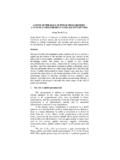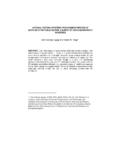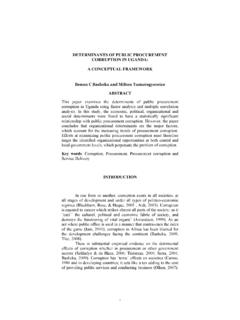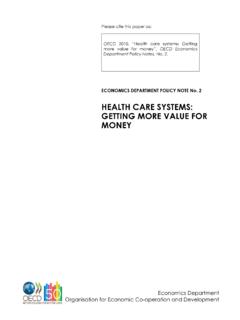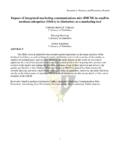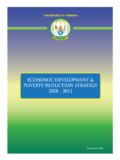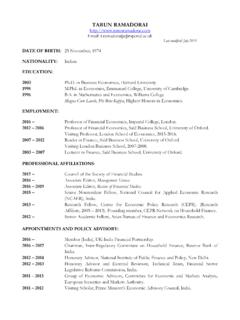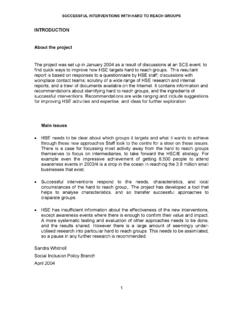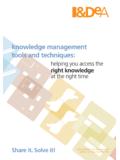Transcription of PUBLIC E-PROCUREMENT - DEFINE, MEASURE …
1 PUBLIC E-PROCUREMENT - define , MEASURE AND optimize ORGANIZATIONAL BENEFITS. Francesco Gardenal Francesco Gardenal, MSc in Economics and Management of PUBLIC Administration and International Institutions. Member of Regional procurement Agency, Lombardia, Italy. His research interests are in PUBLIC procurement , change management, game theory and e-government. ABSTRACT This paper analyzes how E-PROCUREMENT could impact the purchasing process of PUBLIC Services. It aims at proposing a model pinpointing and quantifying performance benefits among organizations. A review of existing literature about E-PROCUREMENT and the impacts of IT-based innovations has been taken into account. The critical factors of success are examined, and six of the main impact dimensions of electronic procurement are precisely set out. The key contribution of this paper is a model, consisting of a specific measurement framework -for each impact dimension- and a cockpit.
2 These instruments are employed to monitor the performance of procurement personnel and the overall effect of the implementation of E-PROCUREMENT . This model has been applied through an analysis of the PUBLIC healthcare sector in Lombardia (the Region of Lombardy). The results are herewith exposed. SUMMARY 1. INTRODUCTION 3 2. E-PROCUREMENT AND ORGANIZATIONAL RENEWAL 3 E-PROCUREMENT Impacts 5 3 PERFORMANCE MEASUREMENT MODEL 9 Efficiency 9 Effectiveness 10 Dematerialization 10 Transparency 11 Competitiveness 12 Governance 12 Method 13 4 SURVEY CONDUCTED ON LOMBARDIA PUBLIC HEALTHCARE SERVICE 14 Why Surveying Lombardia PUBLIC Healthcare Service 15 Findings of the Survey 16 Cockpit of Key Indicators 20 5 CONCLUSIONS 22 6 REFERENCES 23 1. INTRODUCTION E-PROCUREMENT is a specific set of instruments, technologies and organizational solutions supporting PUBLIC procurement processes, particularly considering the possibility to manage tendering procedures and auctions online (e-tendering, e-auctioning).
3 This paper analyzes the impacts that E-PROCUREMENT could produce in PUBLIC supply chains, the main goal is to define a model to MEASURE the performances of PUBLIC procurement activities, by quantifying organizational benefits deriving from introducing this innovation. Literature about IT based innovations has been reviewed to identify the critical success factors (CSF) to achieve the benefits related to the use of electronic instruments in procurement . Thus, a definition of six impact dimensions on organizational performances is provided: efficiency, effectiveness, transparency, competitiveness, governance and dematerialization. Each of the six impact dimensions is part of the performance measurement model herewith proposed; they are described by a set of indicators. Specialized literature lacks a similar model, therefore the paper identifies both its characteristics and its usage modalities.
4 The results of the first survey based on this methodology are given, the survey has been conducted on Lombardia PUBLIC Healthcare Service. The data will highlight the interesting benefits that the healthcare sector is already experiencing, thanks to the usage of E-PROCUREMENT web platforms, although the implementation of this instruments has been carried out only recently. 2. E-PROCUREMENT AND ORGANIZATIONAL RENEWAL Literature and specific research contributions on E-PROCUREMENT and the implementation of these instruments begun to develop only during the last decade, especially considering PUBLIC Services. The first papers dedicated to these issues date back the end of the 90s, the authors stressed the importance of employing IT in procurement activities and handling the benefits. It has been highlighted that E-PROCUREMENT has to be evaluated in its complexity, which encompasses numerous goals: to rationalize expenditure, to reduce administrative confusion and costs, to foster operational efficiency, to strengthen organizations network vision and technological collaboration with business partners, even to completely automate certain procurement activities (Croom, 2000; Gamble, 1999; Greenemeier, 2000 and Murray, 2001).
5 In order to achieve these goals, the implementation of E-PROCUREMENT has to be carried out alongside a complete revision of procurement processes, which would include an accurate selection of suppliers, strategic bargaining of contracts, monitoring of performance, both of buyers and suppliers. Moreover, it is necessary to move towards a systemic usage of this technological innovation, with a continuous flux of electronic purchasing activities affecting important volumes of expenditure (Ramayah, Zbib, Jantan e Koh, 2006). The pros and cons of IT based innovations in complex organizations have encouraged a plethora of studies that investigated these impacts under a variety of points of view. The contributions of Davenport and Andersen have been particularly considered to develop the procurement performance measurement model presented in this paper. T. H. Davenport (1994) defines 9 principal groups of specific effects of IT on organizational processes: automating (eliminating or reducing drastically the effort of human resources), informative (generating more information and allow a better understanding of it), sequential (modifying the sequence of the process and the activities that are part of them), of control (improving monitoring), analytical (improving the understanding of the phenomena), geographical (improving the ability to coordinate remote processes), integrative (assuring coordination among tasks and processes), intellectual (getting and spreading knowledge), disintermediation (reducing redundancy and intermediate activities).
6 In e-Government in action, Andersen analyzes the subject in a broader perspective: Information Technology produces direct effects on organizational skills, as far as effectiveness and efficiency of the processes are concerned. On the other hand, IT indirectly affects organizational interactions, coordination and cooperation, interaction models, internal control and organizational power. Particularly regarding the Italian healthcare sector (herewith analyzed), Nasi (2005) took up the paradigm people process technology (PPT) to define the CSF to effectively achieve an organizational improvement through IT. Technology: such as web sites, ERP, system security, digital signature. Process: a thorough business process re-engineering is needed along with the adoption of standards and coding acknowledged internationally. People: it is necessary to raise awareness and train the employees on themes such as sharing knowledge through IT, networking and change management.
7 On the basis of this contribution, the CSF to successfully employ E-PROCUREMENT (and get the positive effects) are shown in TAB. 1. Extra-organizational relevant factors (environment) have been added to the classic PPT paradigm. TAB. 1 Critical success factors to successfully employ E-PROCUREMENT and get the positive effects Technology Availability of a suitable and capillary IT infrastructure Integration among the applications ( E-PROCUREMENT web platform and ERP) An E-PROCUREMENT web platform, which has to be complete, user-friendly and free Process Business process re-engineering on the basis of shared organizational models Adoption of standard commodity categorizations ( CPV coding) Adjustment of internal rulesShared logics and methodology for measuring, reporting and publicize the results People Raising awareness towards the use of new technologies, training, networking and management techniques. Training on E-PROCUREMENT tools Technical, legal and strategic consultancy for the first tendering procedures Political definition of goals related to the effective use of E-PROCUREMENT A comprehensive and unique normative discipline Creation and development of PUBLIC "centers of excellence" whose goal has to be the diffusion of knowledge and innovative tools.
8 Facilitations to involve suppliers, often tied to the traditional modus operandi E-PROCUREMENT Impacts Precise definitions of E-PROCUREMENT positive effects ( impacts ) will be given in the present chapter, starting from those defined by Davenport and Andersen and applying them to the case of E-PROCUREMENT . The results are shown in TAB. 2 and 3. TAB. 2 - E-PROCUREMENT impacts on organizations (Regional procurement Agency 2009, Davenport, 1997) Automating Eliminate or reduce drastically the effort of human resources Automation or reduction of the duration of the phases of the process Sending of the invitations to the suppliers and publishing of the tendering procedure documentation. Technical / qualitative evaluation of the offers (only when non-discretionary parameters are defined). Anomalous offers evaluation. Use of e-auctions. Final and intermediate report production, archiving of the documents received. Informative Generate more information and allow a better understanding of it Quality and availability of information Tender documents are available from more sources.
9 Tendering procedure documentation is more accurate, as the employees can spend more time in its preparation. Documents produced by every user of the platform are shared and available for consultation (spreading of the best practices). Sequential Modify the sequence of the process and the acitivity that compone them Standardizing, expediting and innovating The tendering procedure is clearly divided in phases, with no possibility of overlap (or forget ) activities. Automation liberates time to be used in activities generating an higher value-added. Creation of standardized tendering procedure template using the platform. Using of new IT instruments ( digital signature, certified email, e-invoicing). Of control Improve monitoring Better organization and archiving of the offers Offers, documents and answers to eligibility requirements, are automatically organized by the platform, in the same way for each supplier. Thus, it s faster and easier to compare the offers and access them in every phase of the process.
10 There is no risk of losing documents or confusing them with those presented by other suppliers, or even regarding a different tendering procedure. Every event or activity regarding a procedure is tracked and available to every stakeholder, anytime. Email alerts notice new events real-time. Analytical Improve the knowledge of phenomena Administrative simplification Standardization of phases and activities allows employees to master the dynamics of a tendering procedure. Every registered user can access to a tendering procedure and check its status Geographical Improve the ability to coordinate remote processes Better communication Easier collaboration and knowledge sharing with other PUBLIC Boards (exchange of documents, messages and contact lists). More effective managing of bundled tendering procedures, like framework contracts. Possibility of working from remote locations. Managers can coordinate many tendering procedures more effectively. Integrative Assure coordination among tasks and processes Univocal attribution of responsibilities The attribution of specific roles and delegations on the platform permit every employee to carry out only the activities within his competence.
